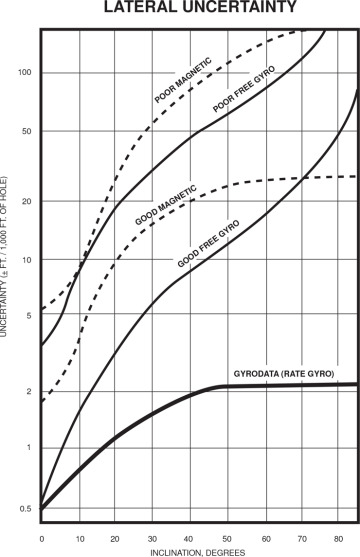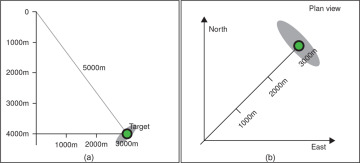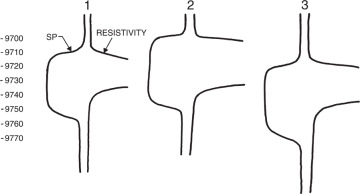- Introduction
- Vertical Wells
- Directionally Drilled Wells
- Application of Directionally Drilled Wells
- Common Types of Directionally Drilled Wells
- Directional Well Plan
- Directional Tools Used for Measurements
- Directional Survey Calculations
- Directional Survey Uncertainties
- Directional Well Plots
- Wells Without Directional Surveys
Directional Survey Uncertainties
The error introduced by the method of calculation becomes almost academic when the other directional survey uncertainties are considered. Uncertainty in measurement can be directly related to the type of survey tool and its operating condition and procedures. The diagrams in Figures 3-19 and 3-20 are derived from a predictive mathematical model that was based on extensive research on North Sea wells by Wolff and de Wardt (1981), who showed that position uncertainties of boreholes are controlled by systematic errors. Vertical uncertainty (Fig. 3-19) refers to inconsistencies in determination of depths. Lateral uncertainty (Fig. 3-20) applies to inconsistencies in determination of lateral position. Magnetic surveys are compared to gyroscopic surveys. The magnetic and free gyroscope surveys display a significant range of potential inaccuracy, which can be due to the quality of survey equipment, operating procedures, and wellbore position. Note that more highly deviated wellbores are subject to more uncertainty in position. The actual predicted amounts of inaccuracy are not directly applicable to areas other than the North Sea, circa 1980, for a variety of reasons. For example, a higher latitudinal position produces more uncertainty in magnetic surveys. Also, the mathematical model does not apply to horizontal wells, including extended-reach wells. Many companies have detailed proprietary information about degree of error in particular types of survey tools, as used under certain operating conditions in given areas.

Figure 3-19 Expected vertical uncertainty in a deviated well considering various types of surveys. (Modified from Wolff and de Wardt 1981. Published by permission of the Journal of Petroleum Technology and Gyrodata, Inc.)

Figure 3-20 Expected lateral uncertainty in a deviated well considering various types of survey tools. (Modified from Wolff and de Wardt 1981. Published by permission of the Journal of Petroleum Technology and Gyrodata, Inc.)
Tenneco Oil Company conducted a detailed study of directional survey uncertainties in 1980. An important conclusion from the study indicates that there is a 90% certainty that any directional well will have an error of 35 ft or less TVD and 140 ft or less in departure. This conclusion is drawn irrespective of MD, hole angle, or survey type. This means that wells with hydrocarbon contacts that vary up to 35 ft TVD may well be in the same reservoir, with the variations due merely to survey error rather than such geological factors as permeability barriers or faults.
Today’s directional surveys are potentially more accurate than those described above, provided that the tools and operating procedures are of high quality. However, that does nothing to mitigate the errors inherent in surveys of older wells. Always remember that data based on directional wells, including new wells, should not be taken at face value. Apparent discrepancies in data used in mapping may be due to errors in depth and lateral position of points in wells. For example, the depth of a mapped surface or a water contact in a deviated well may not match satisfactorily with depths at nearby points. The reason could be an error in the directional survey or perhaps in the spotting of the wellbore. The same caution applies even to data discrepancy in a vertical well, which may have a significant but unrecognized deviation from the vertical.
Jamieson (2012) gives some typical current uncertainties in modern directional surveys. He states that a typical uncertainty in MD is 2 m/1000 m, a typical uncertainty in inclination is 0.3 deg, and a typical uncertainty in azimuth is 1 deg. These uncertainties result in a cone of location uncertainty along the wellbore and ellipses of uncertainty at TD (Fig. 3-21).

Figure 3-21 Ellipses of uncertainty in a hypothetical well drilled 4000 m vertically and then 3000 m horizontally and surveyed with modern directional survey tools. (a) Vertical section showing vertical and lateral uncertainty in a vertical plane. (b) Plan view showing lateral uncertainty. (Jamieson 2012. Published with permission of the author.)
Survey errors can be corrected in some cases in fields that have hydrocarbon/water contacts. Wells are often “corrected” to fit the contact. This is usually done by selecting a contact that fits most of the wells and then adjusting the depth of the well(s) that does not fit. An example of how to adjust a well is shown in Figure 3-22. The water contact in Wells No. 1 and 2 is at a depth of −9738 ft, whereas the contact in Well No. 3 is at a depth of −9748 ft. As data from two wells are in agreement with a water contact at −9738 ft, Well No. 3 is adjusted upward 10 ft to correct the water level from −9748 ft to −9738 ft. Not only is the water level corrected, but the structural depths of the sand (top and base) are also corrected upward 10 ft. Therefore, the top of the sand at a depth of −9720 ft becomes −9710 ft. In some cases, with stacked pays, depth shifting wells to produce a flat-water contact at one horizon will also significantly reduce water contact depth variation at other horizons. An understanding of directional survey errors can at times eliminate the need for a “production fault” or “permeability barrier” to explain discrepancies in water levels. Avoiding such production faults or permeability barriers can have a significant impact on field development plans.

Figure 3-22 Different hydrocarbon/water contacts caused by directional survey errors.
Sag Correction in MWD Directional Surveys
The BHA of the tool string has to be flexible enough to pass through curves in the wellbore. When wells are drilled at high inclinations, the flexibility of the BHA causes it to sag, which can cause an error in the inclination reading of the sensor (Jamieson 2012). Wells drilled at inclinations above 45 deg should have sag corrections applied to the MWD directional survey. If a well with an MWD survey does not seem to fit the map or if production is disappointing, it could be due to a failure to apply a sag correction (Jamieson, 2012).
